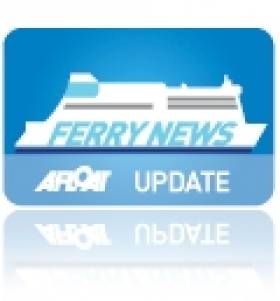Displaying items by tag: SeasonalServices
#TheEasterFerries – Ferries are gearing up in advance of the busy Easter break with vessels dry-docking or leaving their hibernation berths ready for Spring service and throughout the season, writes Jehan Ashmore.
On the North Channel, P&O Ferries seasonal fast-craft Express had departed her winter lay-up in Belfast Port yesterday to undertake a passage to Scotland.
This took the 91m Incat craft to Cairnryan, to where P&O Ferries operate year-round services by conventional ro-pax ferries to and from the route to Larne. It is from the Co. Antrim ferryport, that Express is to start operating in just over a fortnight on the seasonal Larne-Troon route with 2 hour 15 minute crossings beginning on 31 March.
Also on the North Channel, the Belfast-Cairnryan route is where Stena Nordica is operating despite her repositioning voyage from Holyhead to Belfast, as previously reported.
It transpires following her direct replacement on the Wales-Dublin Port route by newcomer Stena Superfast X, the smaller ro-pax is to continue in company service before heading for a new career on the Strait of Dover.
She is serving on the Northern Ireland-Scotland route so to cover Belfast-Cairnryan route Superfast sisters as they take turns to go for overhaul. In which Stena Superfast VII is currently in Harland & Wolf's Belfast dry-dock.
This leaves Stena Superfast VIII running alongside the stand-in 'Nordica' which is the same name of an older ferry that was mentioned by Dan Sten Olsson during his speech of the launch of the Dublin-Holyhead Superfast X last week.
The chairman of Stena referred to the former Stena Nordica as the Swedish company's first ferry to operate on the Irish Sea. The ferry was then in a chartered capacity during service in 1971 on the old Larne-Stranraer route.
In the context of the short sea-route link between these islands, the current Stena Nordica is to start a new career on the Dover-Calais route while under charter to DFDS Seaways. By coincidence, Stena Superfast X had operated for the Danish operator also on the same route while under charter from Stena as Dieppe Seaways.




























































